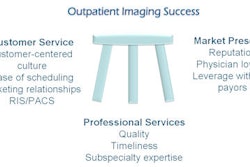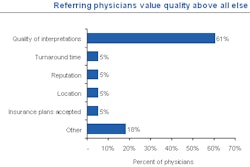Medicare spent $1.7 billion less on imaging services in 2007 thanks to the reimbursement cuts mandated by the Deficit Reduction Act of 2005, according to a report issued by the U.S. Government Accountability Office (GAO). The decline represents the first year-over-year drop in Medicare spending on imaging since 2000, the report states.
The report, "Medicare: Trends in Fees, Utilization, and Expenditures for Imaging Services Before and After Implementation of the Deficit Reduction Act of 2005," tracks the impact of the DRA on outpatient imaging services. The report is part of the GAO's effort to analyze the impact of the DRA legislation; in July the agency issued a report recommending preauthorization as a way to reduce Medicare spending on medical imaging.
The new report examines to what extent payments for imaging tests were affected by the DRA in 2007, specifically by the so-called outpatient prospective payment system (OPPS) cap -- DRA's requirement that Medicare fees for certain imaging services covered by the physician fee schedule not exceed what Medicare pays for these same services under its hospital OPPS. The report also addresses trends in spending and use for imaging services under Medicare's fee-for-service program through 2007.
To evaluate how fees for imaging tests were affected by the OPPS cap in 2007, the GAO used data from the 2007 physician fee schedule and the Centers for Medicare and Medicaid Service's (CMS) Physician Supplier Procedure Summary (PSPS) Master File, as well as the 2008 Medicare Trustees report. To analyze trends in spending and use of imaging services, it used the same data sources but also added information on the number of fee-for-service beneficiaries from the trustees report and PSPS claims data from 2000 to 2006.
Arresting analysis
The report found that the OPPS cap reduced fees for one in four imaging tests overall. Fees for advanced tests, such as CT, MRI, and nuclear medicine, were more likely to be paid at the capped rate: in fact, nearly all MRIs and CTs were paid at the lower OPPS rate. Of the 65.9 million physician imaging exams performed in 2007, 23% were paid at the OPPS rate; of the 13.3 million advanced imaging tests (20% of the total volume of tests done in 2007), 65% were paid at the lower rate.
Fee reductions weren't consistent, however. Among the three more common MRI procedures subject to the cap (MRI of the lumbar spine without contrast, MRI of the joints of the lower extremity without contrast, and MRI of the brain, with and without contrast), reductions ranged from 21% to 40%. Among the three most commonly performed CT exams subject to the cap (CT of the pelvis with contrast, CT of the thorax with contrast, and CT of the thorax without contrast), reductions ranged from 7% to 15%.
The OPPS cap was the main contributing factor to the decline in Medicare spending in imaging services in 2007, the report states, but utilization continued to rise, with the volume of imaging tests subject to the OPPS cap growing four times faster than those tests not subject to it.
The report said the enactment of the DRA stopped a long climb in Medicare payments for imaging services. From 2000 to 2006, total expenditures for imaging services doubled, from $6.7 billion to $13.8 billion, an increase of 12.9% per year. During that same period, the rate of growth in spending for advanced imaging procedures was twice the rate of growth for other imaging exams.
But in 2007, the increase in spending on physician imaging services reversed, and Medicare's expenditures for imaging exams fell to $12.1 billion, a decline of 12.7% from 2006.
But imaging advocates, such as the Access to Medicare Imaging Coalition (AMIC), disputed the GAO report's conclusions.
According to AMIC, the DRA cuts have threatened patient access to imaging services, and the group claims that the cuts are even deeper than Congress originally intended. The problem of access to imaging services is even more dire than predicted, particularly for the elderly.
"The GAO has confirmed what we've been telling Congress for the past four years: the DRA made cuts beyond what the [Congressional Budget Office] and CMS imagined," said Tim Trysla, executive director of AMIC. "This latest report confirms what we've been hearing from the field: that the DRA has had a dramatic impact on imaging centers' ability to stay afloat."
By Kate Madden Yee
AuntMinnie.com staff writer
September 26, 2008
Related Reading
GAO report on overutilization draws industry ire, July 15, 2008
President threatens to veto Medicare bill, July 14, 2008
Physician pay cuts averted as Senate passes Medicare bill, July 10, 2008
CMS delays Medicare payments due to SGR impasse, July 1, 2008
U.S. Senate blocks Medicare bill with HMO cuts, June 27, 2008
Copyright © 2008 AuntMinnie.com



















